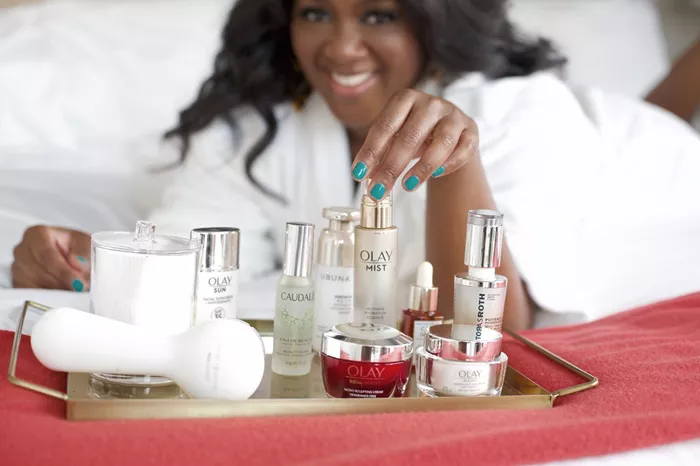A well-structured skincare routine can enhance your skin’s health and appearance. However, using products in the wrong order may reduce their effectiveness. Layering skincare products properly helps your skin absorb the active ingredients and maximizes their benefits. In this guide, we will break down the correct way to apply skincare products and explain why each step matters.
Why Is Skincare Layering Important?
Layering your skincare products correctly ensures that each product can penetrate the skin and perform its function effectively. Some products are water-based, while others are oil-based. Since oil repels water, applying oil-based products too early can create a barrier that prevents water-based products from absorbing properly.
By following the right order, you can get the most out of your skincare routine and prevent issues such as clogged pores, irritation, or reduced effectiveness of your skincare products.
Step-by-Step Guide to Layering Skincare Products
1. Start with a Gentle Cleanser
Cleansing removes dirt, oil, and makeup from your skin. Choose a cleanser that suits your skin type:
- For dry or sensitive skin: Use a hydrating cleanser with ingredients like glycerin or ceramides.
- For oily or acne-prone skin: Use a foaming or gel cleanser with salicylic acid or tea tree oil.
- For combination skin: Use a mild cleanser that balances hydration and oil control.
Cleansing prepares your skin for the rest of your routine and allows products to absorb better.
2. Use a Toner
Toner helps to remove any leftover residue after cleansing and balances your skin’s pH. Depending on your skin type, choose a toner that provides hydration, soothes irritation, or controls oil.
- For dry skin: Use a hydrating toner with hyaluronic acid.
- For oily skin: Choose an astringent toner with witch hazel or niacinamide.
- For sensitive skin: Go for an alcohol-free toner with chamomile or aloe vera.
3. Apply Essence or Facial Mist (Optional)
Essences provide an extra layer of hydration and prep the skin for better absorption of serums. If you prefer a facial mist, ensure it contains beneficial ingredients like rose water or green tea extract.
4. Use Serums and Treatments
Serums contain concentrated active ingredients that address specific skin concerns such as aging, acne, or pigmentation. Apply them in order of thickness, from thinnest to thickest. Common serums include:
- Vitamin C serum: Brightens skin and protects against free radicals.
- Hyaluronic acid serum: Provides deep hydration.
- Niacinamide serum: Controls oil and reduces redness.
- Retinol serum: Helps with anti-aging and collagen production (best used at night).
Allow the serums to absorb fully before moving to the next step.
5. Apply Eye Cream
Eye creams help hydrate and protect the delicate skin around your eyes. Gently pat (do not rub) a small amount around the eye area. Ingredients to look for include:
- Hyaluronic acid: For hydration.
- Caffeine: To reduce puffiness.
- Peptides: To improve skin elasticity.
6. Use a Moisturizer
Moisturizer locks in hydration and seals in the previous layers. Choose a moisturizer based on your skin type:
- For dry skin: Use a rich, creamy moisturizer.
- For oily skin: Use a lightweight, oil-free gel moisturizer.
- For combination skin: Use a balancing moisturizer that provides hydration without heaviness.
7. Apply Face Oil (Optional)
If you use facial oil, apply it after your moisturizer to lock in hydration. Oils can provide extra nourishment, especially for dry or mature skin. Popular facial oils include:
- Argan oil: For hydration and anti-aging.
- Rosehip oil: For brightening and repairing the skin.
- Jojoba oil: For balancing oil production.
8. Use Sunscreen (Morning Routine Only)
Sunscreen is the most important step in your morning routine. It protects your skin from harmful UV rays, preventing premature aging and sun damage. Choose a broad-spectrum SPF 30 or higher and apply it generously.
- Chemical sunscreen: Absorbs into the skin and offers lightweight protection.
- Physical (mineral) sunscreen: Sits on top of the skin and reflects UV rays, making it ideal for sensitive skin.
Reapply sunscreen every two hours if you are exposed to sunlight.
Additional Tips for Skincare Layering
1. Allow Each Product to Absorb
Wait at least 30 seconds to 1 minute between each step to let the product absorb properly. If you layer too quickly, products may pill or lose effectiveness.
2. Apply Products from Thinnest to Thickest
Always start with water-based products and finish with oil-based products. This helps ensure proper absorption and prevents heavier products from blocking lighter ones.
3. Use Only What Your Skin Needs
Overloading your skin with too many products can lead to irritation or breakouts. Stick to essential products based on your skin type and concerns.
4. Adjust Based on Morning vs. Night Routine
- Morning Routine: Focus on hydration, protection (antioxidants), and sunscreen.
- Night Routine: Include treatments like retinol and rich moisturizers to repair the skin overnight.
5. Patch Test New Products
Before applying a new product to your face, test it on a small area to check for any allergic reactions or irritation.
Conclusion
Properly layering your skincare products enhances their effectiveness and helps maintain healthy skin. Always start with cleansing and work your way up to heavier products like moisturizers and oils. Don’t forget to apply sunscreen in the morning to protect your skin from UV damage. With the right routine and consistency, your skin will stay hydrated, protected, and glowing.
Related topic:
How To Layer Morning Skincare?
Why Is Sunscreen Important For Skin Care?

